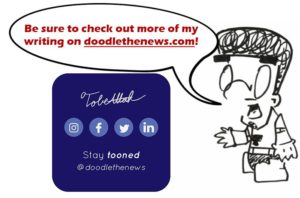A Qualitative Approach To Tackling DOodle the NEWS Presentations (Capstone)
Everyone has an ultimate goal when pursuing a one-year Master’s program at Newhouse, and luckily certain curricula help students achieve those goals. With my capstone and news media start up DOodle the NEWS (DtN) up and running, I’ve had the pleasure of integrating my platform into my course work. Some of my classes this semester have truly made me think outside the box when navigating the space of multimedia entrepreneurship!
Ironically enough, it was not ICC 600 (a class entirely tailored to working on my startup) that sparked this unexpected curiosity. It was EDU 603, a required qualitative research methods course.
Fortunately, the first day of lecture truly helped me understand exactly what qualitative research is and how I can apply it to my capstone. I have only considered gathering quantitative research data for DtN (like this survey I made for a presentation I did a while back), and it has tremendously helped me see what my audience would like to consume.
But how valid are the results I gather from a survey like that? Did I really interact with my audience in a genuine way that observes their opinions and interactions about the news? Qualitative research methods, when applied correctly, can truly uncover those key data points I may need in order to find a sustainable business model for DtN.
So as I think of ways to conduct inductive research on my target audience (which I’m thinking is 17-25 year olds), I have to consider the setting in which I can operate DtN naturally. My initial thought process led me to reflect on my time presenting DtN to an audience of high school students, hoping to gain new fans, followers, and even interns!
As it turns out, my return on investment was very low for what I was expecting.
Only about 12% of kids reported having interest in citizen journalism, but not a single person emailed me inquiring on how to get started. Statistically speaking, at least 10 (147 surveyed) should have been interested based on what they reported, but obviously that was not the case.
This is where qualitative research may come in handy. Perhaps I need to study my audience’s own frame of reference from a less external means.
I will have plenty of time this semester to iron out exactly what I can/will research for this EDU 603 course in relation with DtN, but here’s a pitch: How can I gather qualitative data on how students react to guest speakers coming in to talk about their news startup? Based on what I have seen in previous presentations of mine, I think I could be on to something.
Some high school students had no mercy when showing me exactly how much they cared about DtN. I can specifically remember three hooligan students making sure I noticed their heads were buried in their arms my entire lecture. Maybe, other students saw their peers’ lack of attention so chose to answer my survey questions (which were at the end of my lecture) positively to make me feel better. It’s these types of externalities that can give me skewed results in data I absolutely need in order to build a successful media startup.
Overall, I’ll make sure to work diligently with Professor Susan Thomas this spring semester to ensure the qualitative research I conduct adds value to my experience as a multimedia entrepreneur. There are tons of layers and branches in this industry that I’ll happily admit I have no clue about, but I will do everything in my power to learn. With these last few months in Syracuse as a graduate student, taking advantage of my time and resources is simply a priority.
But from time to time, it’s always nice to take a breather and relax by doing things you love. For me, one of those things is writing. Thanks to those of you who are reading along.







